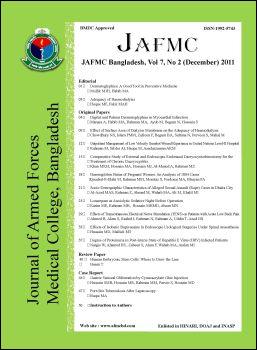Effects Of Transcutaneous Electrical Nerve Stimulation (Tens) On Patients With Acute Low Back Pain
DOI:
https://doi.org/10.3329/jafmc.v7i2.10393Keywords:
Transcutaneous electrical nerve stimulation (TENS), acute low back pain (LBP)Abstract
Background: Acute low back pain (LBP) affects a significant proportion of the population. Transcutaneous electrical nerve stimulation (TENS) was introduced more than 30 years ago as an adjunct to the pharmacological management of pain. However, despite its widespread use, the usefulness of TENS in LBP is still controversial. Introduction: LBP is a common problem in Bangladesh. Acute LBP is usually defined by a period of complaints of LBP of six weeks or shorter. TENS may improve acute LBP.
Objective: To evaluate the effectiveness of TENS on acute LBP and also to ensure the patients wellbeing by shortening recovery time who have acute LBP.
Methods: A prospective study was carried out in the Department of Physical Medicine and Rehabilitation, Bangubandhu Sheikh Mujib Medical University (BSMMU), Dhaka, Bangladesh, from July 2008 to December 2008. The patients were divided into two groups (A and B). Patients of Group A (30 patients) were treated with TENS, Non-steroidal anti-inflammatory drugs (NSAIDs) and activities of daily living (ADLs) instruction. Patients of group B (28 patients) were treated with NSAIDs and ADLs instructions.
Results: A total of 58 Patients of acute LBP were included in this study. The mean age of the patients was 38.5 ± 9.01 years. Main causes of pain were muscle strain (39.65%), nonspecific LBP (22.41%), prolapsed lumber intervertebral disc (17.24%), lumbar spondylosis (13.79%) and sciatica (6.91%). After treatment the result was compared and student's 't' test was done to see the level of significance. Method was found significant after treatment (p<0.05). Twenty four (80%) patients were improved in group A and 18 (64.28%) patients in group B. Patient compliances of group A were better than that in group B.
Conclusion: Effect of TENS on patients with acute low back pain is beneficial.
DOI: http://dx.doi.org/10.3329/jafmc.v7i2.10393
JAFMC 2011; 7(2): 29-32
Downloads
516
513

